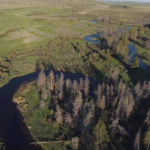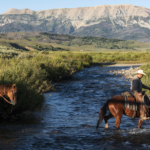Take a drive around any given small town in rural American on any given summer night, and there is a good chance of finding a throng of trucks and trailers, cowboys and cowgirls, livestock and rough stock, parked around the metal fences of a dirt arena. At once gritty and pastoral, it’s a scene iconic to the American West—Rodeo. And from the proverbial one-horse town to the country’s biggest cities, its popularity is burgeoning.
In many ways, rodeo’s success itself bucks convention. As many remote communities – the kind of places where cell coverage is still spotty and population signs read like they are missing a digit – struggle against population declines and economic stagnation, the sport born from their traditions and fast-disappearing lifestyles is now riding high.
Nationwide, there are more than 600 rodeos sanctioned by the Professional Rodeo Cowboys Association (PRCA). Countless more are operated independently. Bull riding, one of rodeo’s marquee competitions, is the fastest growing sport in the United States.
They say true cowboys are a dying breed, but not judging by their sport. From association memberships to airtime, most metrics point towards growth, especially at the professional level.
The rising number of competitors owes to a myriad of factors, like high school and even peewee rodeo programs that introduce the sport at a younger age and a stable economy (pro rodeo participation fell to near-record lows in 2009). But it’s also fed by the sport’s mounting celebrity. Rodeo has become a staple on many television networks, and audiences, in person and by broadcast, have steadily grown—as have the jackpots. Prize money hit an all-time high of more than $46 million in 2015.
There’s a strong case that rodeo’s entry into the mainstream is a result of the very suburbanization that has put mounting pressure on the communities typically associated with the sport. Over three-quarters of the U.S. population today lives in an urban location. In 2010, there were more than 41 metros areas with populations above 1 million people, up from 12 in 1950 and projected to grow to 53 by 2030. With limited access to ranching and agriculture, the spectacle of rodeo is even more pronounced within those demographics, which has helped to drive ratings.
But perhaps the more convincing case for rodeo’s sudden surge in popularity is less nuanced. The sport is a celebration of the heritage and lifestyles on which much of the country was built. Competitors and spectators stand and doff their hats for the National Anthem. They put a hand over their hearts for the Pledge of Allegiance. And they take a moment of silence for those who gave their life in service to our country.
And then there’s the sheer thrill of the sport. The teamwork between horse and rider for the timed events, the contest between animal and athlete for the judged events, and, of course, the unpredictability of the livestock throughout—there are few competitions that require such measures of athleticism and daring, and both in spades.
“People identify with what the cowboy represents,” Troy Ellerman, a former commissioner of the PRCA, said in a 2006 interview. “We are a slice of America that’s carved out an identity for itself and is becoming more and more popular. And a 2,500-pound animal against a 150-pound guy? It’s pretty good to watch.”
That’s proven prescient. Rodeo’s growing stature has created a booming industry. The Houston Rodeo, one of the largest in the country, generated some $391 in economic activity this year from ticket and on-site sales, lodging, food and auxiliary purchases. That spending created nearly 4,000 jobs in the area, according to research by Economics Analytics Consulting, LLC.
The National Finals Rodeo in Las Vegas, often called the Super Bowl of rodeo, generated $113 million in spending over 10 days last December, according to conservative estimates. Wyoming’s Cheyenne Frontier Days, “The Daddy of ‘Em All,” created over $27 million in economic activity last year, and the annual Reno Rodeo pulled nearly $60 million into the local economy. Such has become a reality of the industry. Big ticket events equate to big money.
For elite competitors, rodeo can be a lucrative living, too, although still modest compared to most major sports. The purse for the National Finals Rodeo this year will top $10 million, or about a $50,000 payout for event winners. PRCA champions generally earn between $200,000 to $500,000 per year, according to the organization’s data. Coupled with often large endorsement packages, top athletes’ earning potential is not insignificant.
In 2016, five-time World Title Champion bull rider Sage Kimzey became PRCA’s youngest millionaire, then only 22 years old. Even so, his combined career earnings of less than $2 million pale in comparison to the multi-million dollar deals regularly inked by professional athletes in better known fields.
Like most sports, it’s not easy to break into the upper echelons of rodeo. Nor is it often a glamorous life. An amateur competitor might collect $10,000 to $15,000 per year, the equivalent of a part time job, the Cowboy Lifestyle Network reported in 2017. But for most aspiring cowboys and cowgirls, there’s nothing part time about the gig.
Competitors travel frequently, often driving long distances from one event to the next. It’s not uncommon for athletes to participate in multiple rodeos in a single day, with no guarantee of a payout when the dust settles. It’s a grueling lifestyle, to be sure, and one that participants roundly agree is driven by a passion for the sport rather than monetary gain.
Even for mid-range competitors, a year’s winnings may not cover their costs of travel and caring for their animals. Health insurance, especially among bronc and bull riders, is generally unheard of; the premiums are simply unrealistic in this line of work. An injury or stroke of bad luck can quickly spell one’s undoing.
“Unless you are at the very top, you will not retire from it,” says Jimmy Crosby, a former bull rider.
In this multi-faceted sport, cowboys aren’t the only ones vying for potentially big winnings. So are the animals. A top-performing bull or bronc can earn significant prize money, and a market has emerged for breeders. Like riders, these animals compete for large purses, which can total over a million dollars for a season. In 2012, for example, Bushwhacker, then the top-ranked PBR bull, was valued at just under $1 million.
“Bull riding is a big business,” James Gorman reported in the New York Times earlier this year. “For the past 15 years or so, bucking bulls have been intensively bred like racehorses to make them harder to ride. Breeders use high-tech reproductive techniques and a detailed, computerized registry of 180,000 bulls and cows…For those who do buck, it’s a sweet life.”
The upshot is a sport that’s becoming increasingly challenging. As Gorman puts it, now all the bulls are hard. In 1995, 46 percent of bull riders completed their ride; today, only 26 percent do. Against such odds, it’s little wonder that rodeo has been called the “most dangerous sport.”
It defies logic, to some degree at least, that cowboys and cowgirls would gamble so much on such long-shot odds for what most likely will amount to a modest income and tough living. But an adrenaline high, the admiration of an anticipatory crowd, the struggle to hang on for eight seconds or set the perfect catch loop—those feelings often don’t conform to reason.
Perhaps that explains rodeo’s growing appeal. At its heart, it is a sport of grit and determination, good luck and strong spirits, fueled by the need to test one’s mettle under the lights of a grandstand and the cheers of a crowd.
In that sense, the sport is emblematic of the West itself: steely, resolute and independent—and yet still somehow dynamic and indomitable. Like the West, it is a thing of uncertainty, where the thrill and reward of the experience is worth the wager of it all.
“The tough part about roping for a living is that there are no guarantees,” says team roper Kendra Santos. “There is no paycheck in your mailbox every other Friday. You’re basically gambling on your skills and the luck of the draw.”
“Still, cowboys are true grit. They do not back down,” Santos adds. “This is something we love. It’s a dream. I know I’ve been doing this for 28 years, and I haven’t been able to shake it.”








